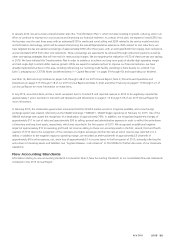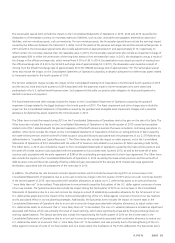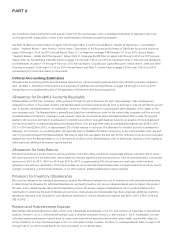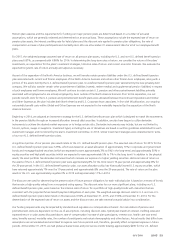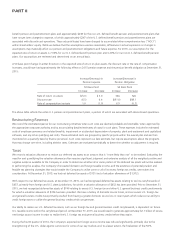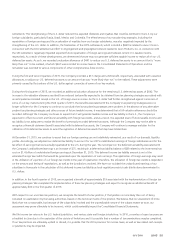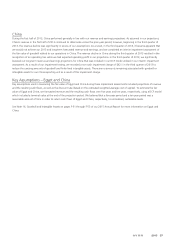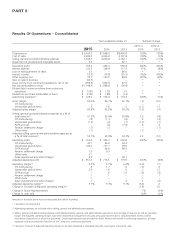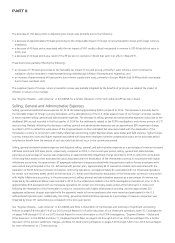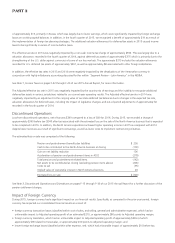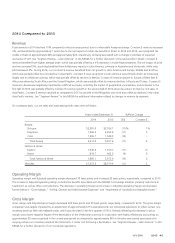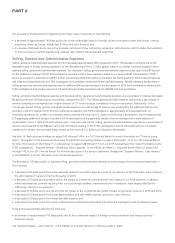Avon 2015 Annual Report Download - page 48
Download and view the complete annual report
Please find page 48 of the 2015 Avon annual report below. You can navigate through the pages in the report by either clicking on the pages listed below, or by using the keyword search tool below to find specific information within the annual report.
PART II
Loss Contingencies
We determine whether to disclose and/or accrue for loss contingencies based on an assessment of whether the risk of loss is remote,
reasonably possible or probable. We record loss contingencies when it is probable that a liability has been incurred and the amount of loss is
reasonably estimable. Our assessment is developed in consultation with our outside counsel and other advisors and is based on an analysis
of possible outcomes under various strategies. Loss contingency assumptions involve judgments that are inherently subjective and can
involve matters that are in litigation, which, by its nature is unpredictable. We believe that our assessment of the probability of loss
contingencies is reasonable, but because of the subjectivity involved and the unpredictable nature of the subject matter at issue, our
assessment may prove ultimately to be incorrect, which could materially impact the Consolidated Financial Statements.
Impairment of Assets
Plant, Property and Equipment and Capitalized Software
We evaluate our plant, property and equipment and capitalized software for impairment whenever events or changes in circumstances
indicate that the carrying amount of an asset group may not be recoverable. Recoverability of assets to be held and used is measured by a
comparison of the carrying amount of an asset to estimated undiscounted future cash flows expected to be generated by the asset. If the
carrying amount of an asset exceeds its estimated future cash flows, an impairment charge is recognized for the amount by which the
carrying amount of the asset exceeds the fair value of the asset.
In February 2015, we reviewed Avon Venezuela’s long-lived assets to determine whether the carrying amount of the assets was recoverable.
Based on our expected cash flows associated with the asset group, we determined that the carrying amount of the assets, carried at their
historical U.S. dollar cost basis, was not recoverable. As such, an impairment charge of $90.3 to selling, general and administrative expenses
was recorded to reflect the write-down of the long-lived assets to their estimated fair value of $15.7, which was recorded in the first quarter
of 2015. The fair value of Avon Venezuela’s long-lived assets was determined using both market and cost valuation approaches. The
valuation analysis performed required several estimates, including market conditions and inflation rates. See Note 1, Description of the
Business and Summary of Significant Accounting Policies on pages F-8 through F-14 of our 2015 Annual Report for more information on
Avon Venezuela.
Goodwill and Intangible Assets
We test goodwill and intangible assets with indefinite lives for impairment annually, and more frequently if circumstances warrant, using
various fair value methods. We review finite-lived intangible assets, which are subject to amortization, for impairment whenever events or
changes in circumstances indicate that the related carrying amounts may not be recoverable.
We completed our annual goodwill impairment assessment for 2015 and determined that the estimated fair values were considered
substantially in excess of the carrying values of each of our reporting units, with the exception of our Egypt reporting unit (discussed below).
The impairment analyses performed for goodwill and intangible assets require several estimates in computing the estimated fair value of a
reporting unit, an indefinite-lived intangible asset, and a finite-lived intangible asset. As part of our goodwill impairment analysis, we
typically use a discounted cash flow (“DCF”) approach to estimate the fair value of a reporting unit, which we believe is the most reliable
indicator of fair value of a business, and is most consistent with the approach that we would generally expect a market participant would
use. In estimating the fair value of our reporting units utilizing a DCF approach, we typically forecast revenue and the resulting cash flows for
periods of five to ten years and include an estimated terminal value at the end of the forecasted period. When determining the appropriate
forecast period for the DCF approach, we consider the amount of time required before the reporting unit achieves what we consider a
normalized, sustainable level of cash flows. The estimation of fair value utilizing a DCF approach includes numerous uncertainties which
require significant judgment when making assumptions of expected growth rates and the selection of discount rates, as well as assumptions
regarding general economic and business conditions, and the structure that would yield the highest economic value, among other factors.
Egypt
During the 2015 year-end close process, our analysis of the Egypt business indicated an impairment as the carrying value of the business
exceeded the estimated fair value. This was primarily the result of reducing our long-term projections of the business. During 2015, Egypt
performed generally in line with our revenue and earnings projections, which assumed growth as compared to 2014. However, as a result of
currency restrictions for the payment of goods in Egypt, we lowered our long-term revenue and earnings projections for the business.
Accordingly, a non-cash impairment charge of $6.9 was recorded to reduce the carrying amount of goodwill. There is no amount remaining
associated with goodwill for our Egypt reporting unit as a result of this impairment charge.
7553_fin.pdf 38





